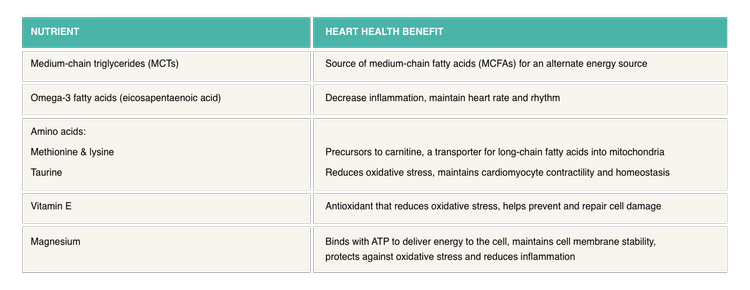
ANATOMICAL HEART

Myxomatous mitral valve disease (MMVD)
Myxomatous mitral valve disease (MMVD) is the most common, naturally acquired canine heart disease.1–4
Dogs with MMVD have progressive mitral valve degeneration. With every heartbeat, the abnormal valve allows blood to leak backward, or regurgitate, into the left atrium. Over time, mitral valve regurgitation (MR) leads to left atrial enlargement, compensatory left ventricular remodeling and, potentially, heart failure.
The mechanisms that cause MMVD are not completely understood. However, studies by Purina scientists indicate a specific blend of nutrients may help slow disease progression, before dogs with MMVD develop heart failure.
Read on to learn about the science behind a novel nutritional intervention to support cardiac health in dogs with early stage MMVD.

The highest incidence of MMVD occurs in older, small- to medium-sized dogs weighing less than 20 kilograms.4, 5
The rate of MMVD progression, from one stage to the next, is variable and hard to predict. However, about 30% of dogs will develop advanced heart disease.6
Dogs appear normal until stage C, when they show signs of congestive heart failure.
Based on the ACVIM consensus guidelines, current nutritional recommendations focus on dogs in later stages of MMVD, after clinical signs of congestive heart failure occur.4
Discovering an intervention that is effective in the earlier stages of this disease could help dogs live better, longer lives.
Purina's research


The heart cannot store energy for future use – it can only keep beating as long as cardiac mitochondria continue to generate ATP.
Studies show that dysfunctional mitochondria, which use less efficient pathways for energy production, contribute to heart failure.7
Current nutritional recommendations for dogs in heart failure are focused on nutrient deficiencies or excesses. But emerging research shows that nutrition can provide alternative energy substrates and cardiac health benefits before the heart starts to fail.7-9
In previous omics studies, Purina scientists found that dogs with MMVD had altered energy metabolism, increased oxidative stress and inflammation.10 Based on these scientific insights, they identified nutrients that could address these metabolic changes.
The cardiac protection blend of nutrients includes:

The results of a 6-month placebo-controlled dietary intervention pilot study suggested a complete and balanced diet with the cardiac protection blend of nutrients (CPB) may help slow progression of early-stage MMVD.11

This blinded, randomized feeding trial enrolled 19 dogs in stage B1 or B2 heart disease. The dogs were divided into two groups randomized by age, sex, breed, body weight, and murmur grade, then fed either a control diet (CON) or the CPB-supplemented diet.
The changes noted in the dogs consuming the CPB-supplemented diet suggest the specific blend of nutrients in the diet may help improve heart function in dogs with stage B1 and B2 MMVD.
Nutrition may play a role in the management of early stages of MMVD.
Metabolomic analysis
In a separate, published Purina study,13 metabolomic analysis showed dogs fed the cardiac protection blend of nutrients also had improved fatty acid use for energy and reduced markers of inflammation and oxidative stress. This suggests that positive changes occurred on a molecular level.
This series of studies demonstrates that dietary intervention, with a blend of specific nutrients developed to address key metabolic changes associated with MMVD in dogs, may help slow the progression of early stage MMVD. The pilot study is a starting point for learning more about the influence of diet (and specific nutrients) in the earlier stages of MMVD and suggests a specific blend of nutrients, based on metabolomics from dogs with B1 and B2 MMVD, may benefit patients in the earlier stages of this disease.

Learn more about how this novel nutritional intervention can transform the management of heart disease in dogs with early stage MMVD
Key things to remember
- MMVD is the most common canine heart disease.
- The rate of MMVD progression is variable but about 30% of dogs develop advanced heart disease.
- Purina scientists identified a blend of nutrients that could potentially address metabolic changes found in dogs with early stage MMVD.
- A 6-month pilot study suggested the specific blend of nutrients, used because of metabolomic findings in dogs with B1 and B2 MMVD, may benefit patients in the earlier stages of this disease.
- Metabolomic analysis after the study showed positive changes at the molecular level in dogs with MMVD fed the specific blend of nutrients.
Explore areas of transforming heart health:
Find out more
- Buchanan, J.W. (1977). Chronic valvular disease (endocardiosis) in dogs. Advances in Veterinary Science, 21, 57–106.
- Detweiler, D. K., & Patterson, D. F. (1965). The prevalence and types of cardiovascular disease in dogs. Annals of the New York Academy of Sciences, 127(1), 481–516.
- Haggstrom, J., Kvart, C., & Pedersen, H.D. (2005). Acquired valvular disease. In: Ettinger, S.J., Feldman, E.C., eds. Textbook of Veterinary Internal Medicine, 6th ed. St Louis: Elsevier: 1022–1039.
- Keene, B. W., Atkins, C. E., Bonagura, J. D., Fox, P. R., Häggström, J., Fuentes, V. L., Oyama, M. A., Rush, J. E., Stepien, R., & Uechi, M. (2019). ACVIM consensus guidelines for the diagnosis and treatment of myxomatous mitral valve disease in dogs. Journal of Veterinary Internal Medicine, 33(3), 1127–1140.
- Atkins, C., Bonagura, J., Ettinger, S., Fox, P., Gordon, S., Haggstrom, J., … Stepien R. (2009). Guidelines for the diagnosis and treatment of canine chronic valvular heart disease. Journal of Veterinary Internal Medicine, 23, 1142–1150.
- Borgarelli, M., & Buchanan, J.W. (2012). Historical review, epidemiology and natural history of degenerative mitral valve disease. Journal of Veterinary Cardiology, 14(1), 93–101.
- Brown, D. A., Perry, J. B., Allen, M. E., Sabbah, H. N., Stauffer, B. L., Shaikh, S. R., … Gheorghiade, M. (2017). Expert consensus document: Mitochondrial function as a therapeutic target in heart failure. Nature reviews. Cardiology, 14(4), 238–250.
- Lopaschuk, G. (2017). Metabolic Modulators in Heart Disease: Past, Present, and Future. Canadian Journal of Cardiology, 33, 838–849.
- Sabbah, H. N. (2020). Targeting the Mitochondria in Heart Failure: A Translational Perspective. JACC. Basic to Translational Science, 5(1), 88–106.
- Li, Q., Freeman, L.M., Rush, J.E., Huggins, G.S., Kennedy, A.D., Labuda, J.A., Laflamme, D.P., & Hannah, S.S. (2015). Veterinary Medicine and Multi-Omics Research for Future Nutrition Targets: Metabolomics and Transcriptomics of the Common Degenerative Mitral Valve Disease in Dogs. OMICS, 19(8), 461–470.
- Li, Q., Heaney, A., Langenfeld-McCoy, N., Boler, B. V., & Laflamme, D. P. (2019). Dietary intervention reduces left atrial enlargement in dogs with early preclinical myxomatous mitral valve disease: a blinded randomized controlled study in 36 dogs. BMC Veterinary Research, 15(1), 425.
- Dickson, D., Caivano, D., Matos, J.N., Summerfield, N., & Rishniw, M. (2017). Two dimensional echocardiographic estimates of left atrial function in healthy dogs and dogs with myxomatous mitral valve disease. Journal of Veterinary Cardiology, 19, 469–479.
- Li, Q., Laflamme, D.P., & Bauer, J. E. (2020). Serum untargeted metabolomic changes in response to dietary intervention on dogs with preclinical myxomatous mitral valve disease. PLoS One, 15(6), 0234404.


